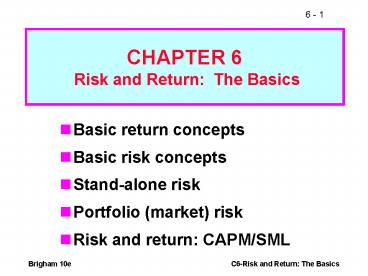Basic return concepts - PowerPoint PPT Presentation
1 / 19
Title:
Basic return concepts
Description:
Market. 17.4% HT. 6 - 11. Brigham 10e C6-Risk and Return: The Basics # Stocks in Portfolio ... The one-stock investor bears higher (stand-alone) risk, so the ... – PowerPoint PPT presentation
Number of Views:80
Avg rating:3.0/5.0
Title: Basic return concepts
1
CHAPTER 6 Risk and Return The Basics
- Basic return concepts
- Basic risk concepts
- Stand-alone risk
- Portfolio (market) risk
- Risk and return CAPM/SML
2
What are investment returns?
- Investment returns measure the financial results
of an investment. - Returns may be historical or prospective
(anticipated). - Returns can be expressed in
- Dollar terms.
- Percentage terms.
3
What is the return on an investment that costs
1,000 and is soldafter 1 year for 1,100?
- Dollar return
Received - Invested 1,100 -
1,000 100.
- Percentage return
Return/ Invested 100/1,000
0.10 10.
4
What is investment risk?
- Typically, investment returns are not known with
certainty. - Investment risk pertains to the probability of
earning a return less than that expected. - The greater the chance of a return far below the
expected return, the greater the risk.
5
Probability distribution
Stock X
Stock Y
Rate of return ()
50
15
0
-20
- Which stock is riskier? Why?
6
Assume the FollowingInvestment Alternatives See
Excel
7
What is unique about the T-bill return?
- The T-bill will return 8 regardless of the state
of the economy. - Is the T-bill riskless? Explain.
8
Do the returns of HT and Collections move with or
counter to the economy?
- HT moves with the economy, so it is positively
correlated with the economy. This is the typical
situation. - Collections moves counter to the economy. Such
negative correlation is unusual.
9
Calculate the expected rate of return on each
alternative.See Excel
k expected rate of return.
kHT 0.10(-22) 0.20(-2) 0.40(20)
0.20(35) 0.10(50) 17.4.
10
- HT has the highest rate of return.
- Does that make it best?
11
?p ()
Company Specific (Diversifiable) Risk
35
Stand-Alone Risk, ?p
20 0
Market Risk
10 20 30 40 2,000
Stocks in Portfolio
12
Stand-alone Market Diversifiable
.
risk risk
risk
Market risk is that part of a securitys
stand-alone risk that cannot be eliminated by
diversification. Firm-specific, or diversifiable,
risk is that part of a securitys stand-alone
risk that can be eliminated by diversification.
13
Conclusions
- As more stocks are added, each new stock has a
smaller risk-reducing impact on the portfolio. - By forming well-diversified portfolios, investors
can eliminate about half the riskiness of owning
a single stock.
14
Can an investor holding one stock earn a return
commensurate with its risk?
- No. Rational investors will minimize risk by
holding portfolios. - They bear only market risk, so prices and returns
reflect this lower risk. - The one-stock investor bears higher (stand-alone)
risk, so the return is less than that required by
the risk.
15
How is market risk measured for individual
securities?
- Market risk, which is relevant for stocks held in
well-diversified portfolios, is defined as the
contribution of a security to the overall
riskiness of the portfolio. - It is measured by a stocks beta coefficient,
which measures the stocks volatility relative to
the market. - Analysts typically use four or five years of
monthly returns to establish the regression line.
Some use 52 weeks of weekly returns.
16
How is beta interpreted?
- If b 1.0, stock has average risk.
- If b gt 1.0, stock is riskier than average.
- If b lt 1.0, stock is less risky than average.
- Most stocks have betas in the range of 0.5 to
1.5. - Can a stock have a negative beta?
17
Expected Return versus Market Risk
- Which of the alternatives is best?
18
Use the SML to calculate eachalternatives
required return.
- The Security Market Line (SML) is part of the
Capital Asset Pricing Model (CAPM).
- SML ki kRF (RPM)bi .
- Assume kRF 8 kM kM 15.
- RPM (kM - kRF) 15 - 8 7.
19
Required Rates of Return
kHT 8.0 (7)(1.29) 8.0 9.0
17.0.
kM 8.0 (7)(1.00) 15.0. kUSR 8.0
(7)(0.68) 12.8. kT-bill 8.0
(7)(0.00) 8.0. kColl 8.0
(7)(-0.86) 2.0.































